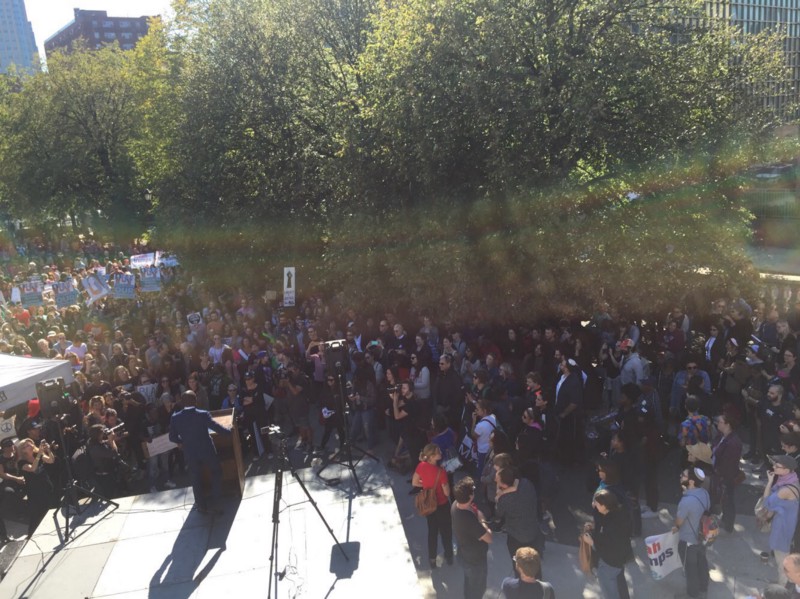
That’s not a headline I had ever anticipated writing. And at a time when progressives seem increasingly dominated by an anti-Israel air, I expect every run-in with that crowd to produce the same pattern of animosity and mistrust. Initially, during my coverage of the recent Sister March for Racial Justice in Brooklyn, I felt my prediction confirmed.
Addressing the crowd from a podium at the Jay Street Plaza, Muslim-American activist, Linda Sarsour, spoke of “right-wing Zionists” in the same breath as white supremacists, creating a vile conflation between Jewish liberation and well, bigotry. One had an aery sense that the targeting was intentional –– an effort to ostracize Pro-Israel Jews and push them out of progressive spaces. And as marchers made their way towards the Brooklyn Bridge, I caught sight of what felt like another irrelevant political injection into the discussion of racial justice in America: a Palestinian flag. It waved to me from the top of a baseball cap of a petite elderly woman and seemed firmly placed above her head.
“From Palestine to Mexico, all the walls have got to go,” the 77-year-old woman chanted. That’s a Jewish Voice for Peace (JVP) line I easily recognized. But aside from the gross fusion of two separate regional and political issues, the word ‘peace’ in JVPs acronym is actually misleading. While their mission statement claims to support “security and self-determination for Israelis and Palestinians,” JVP operates as an anti-Israel organization, supporting movements like BDS (boycott, divestment, and sanctions), which aims to destroy the Jewish state economically.
The woman explained that she’d recently become a member of theirs. I quieted my inner reservations and aimed to understand why. Maybe it was the soft lines in her face or her warm outstretched arms –– pulling me closer from time to time so that I could hear her better –– that made me want to stay and talk to Jane Orendain.
After revealing her native Filipino roots and Catalonian lineage, Orendain drew what felt like an associative approach to the Israeli-Palestinian conflict. Her ethnic background –– a mixture of peoples seeking autonomy and independence –– must have guided her in the direction of sticking-up-for-the-little-guy just as my own identity helped inform my own views. Even though her chant sounded like veiled slander against my people, I suddenly understood why her free-Palestine stance seemed like a natural spot for her to reside in.
But then, when asked to get more specific about Israeli policy, Orendain revealed that she envisions “a Two-State Solution”––for Israelis and Palestinians to live side-by-side in peace. Surprised and impressed by her position, I informed Orendain that the Israeli government actually supports an independent Palestinian state based on secure borders for both peoples. I told her that most Zionists I’ve met uphold that as well. “What? They do? Really?” Orendain responded, positively stunned.
As she ingested my words, it occurred to me that I might have been the first person to ever reveal that bit of news to her. And I thought: perhaps our ideological opponents aren’t as unreachable as we think. It’s much easier, though, to scan a banner and feel like an enemy has been successfully identified. It’s a lot harder to remember that a human stands behind the picket –– their sensitivities real, their ideas changeable.
After parting from Orendain, I carried on with a brightened sense of hope that I’d again find conversation and commonality in an unexpected place. It was as if the anti-Zionist rhetoric heard earlier in the march suddenly evaporated. I saw a much larger goal ahead. I recognized the value of engaging with those whom I might have initially written-off.
Now, this doesn’t mean that JVP members and other anti-Israeli folks will suddenly drop their ideological armor and embrace a Zionist’s perspective. But it does mean that somewhere in a seemingly hostile crowd, one might find a marcher with a pair of wide ears and open eyes that’ll walk beside them and in good faith, engage.
Contributed by City College of New York CAMERA Fellow Oshra Bitton.
This article was originally published in Harlem Focus.
